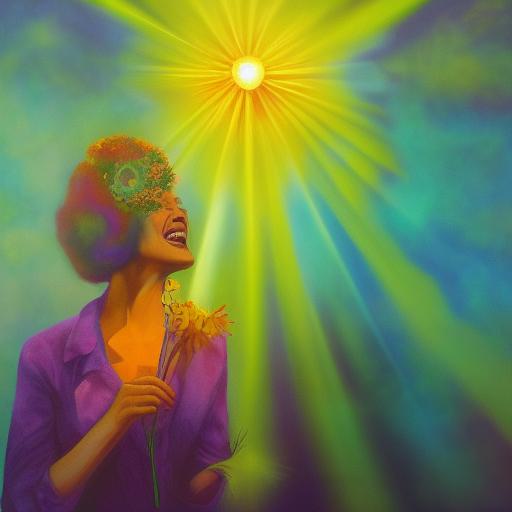How to write this prompt?
To create an AI image prompt like the one mentioned above, one needs to consider the following key components and their respective impacts on the image being generated:
- Description of the subject: Start by describing the subject or object in detail. In this prompt, the woman is described as holding a laughing flower. This will help the AI generate an image with the woman holding a flower in her hand.
- Composition and camera angle: The composition and camera angle of the artwork are essential in determining the visual perspective of the image. In this prompt, the camera is angled from a low angle and set to an ultra-wide view. This will influence the AI to create an image that appears to be taken from a low angle with a wide-angle lens.
- Color scheme: The color scheme sets the mood and tone of the artwork. In this prompt, the color scheme is primarily shades of green and yellow, creating a vibrant and lively quality to the painting. This will encourage the AI to generate an image with a similar color scheme.
- Atmospheric elements: The use of atmospheric elements can significantly impact the mood and ambiance of the artwork. In this prompt, the volumetric fog in the background creates a mystical atmosphere, which the AI can use to generate a foggy or misty background.
- Lighting: The lighting in the prompt is described as having crepuscular rays, which adds to the psychedelic effect. This will influence the AI to create an image with similar lighting, possibly with rays of light shining down on the woman and the flower she is holding.
By carefully describing each component of the image, an AI prompt can be created that guides the AI to generate an image that aligns with the intended concept.
What is an AI image prompt?
An AI image prompt is a set of instructions given to an artificial intelligence system that guides it to create an image based on specific criteria or guidelines. It can include elements such as subject matter, composition, color scheme, and lighting.
How to create a compelling psychedelic artwork using AI?
To create a compelling psychedelic artwork using AI, one can start by describing the subject or object in detail, selecting a color scheme that is vibrant and lively, using atmospheric elements such as volumetric fog or smoke, and incorporating dramatic lighting with crepuscular rays. One can also experiment with different camera angles and compositions to achieve a unique perspective.
Why is camera angle important in creating an AI-generated image?
Camera angle is essential in creating an AI-generated image as it determines the visual perspective of the artwork. Different camera angles can convey different emotions or moods, and can significantly impact the final image’s composition and aesthetic. For example, a low angle can create a sense of dominance or power, while a high angle can convey vulnerability or weakness.
What are some examples of AI-generated art?
- “Portrait of Edmond de Belamy” – a painting created by Paris-based art collective, Obvious, using a generative adversarial network (GAN). It sold at auction for $432,500 in 2018.
- “The Next Rembrandt” – a project by ING Bank and J. Walter Thompson Amsterdam that used AI algorithms to create a new painting in the style of Rembrandt.
- “AICAN” – an AI artist created by Rutgers University that can generate original artworks without human intervention.
- “DeepDream” – a Google AI project that transforms images into dream-like compositions.
Are there any ethical concerns related to AI art generation?
As with any technology, there are ethical concerns related to AI art generation. Some of these concerns include:
- Ownership and copyright – who owns the rights to an AI-generated artwork? Is it the artist who created the algorithm or the person who trained the AI?
- Bias – AI algorithms are only as unbiased as the data they are trained on. If the data used to train the AI contains biases, those biases may be reflected in the generated artwork.
- Authenticity – with AI-generated art, it can be difficult to determine whether the artwork was truly created by the AI or if it was manipulated by a human artist.
- Cultural appropriation – some AI art generation projects have been criticized for appropriating cultural traditions or styles without proper attribution or understanding.
- Job displacement – as AI becomes more sophisticated, it may replace human artists in certain areas of the art industry, raising concerns about job displacement and income inequality.
Enhance your designs with stunning AI-generated art using Visual Paradigm Online. With just a few clicks, you can incorporate unique and visually appealing graphics into your projects, thanks to the platform’s user-friendly interface and a wide selection of design templates and assets. Experiment with various styles and layouts until you achieve the perfect combination for your needs. Try Visual Paradigm Online today and take your designs to the next level!


